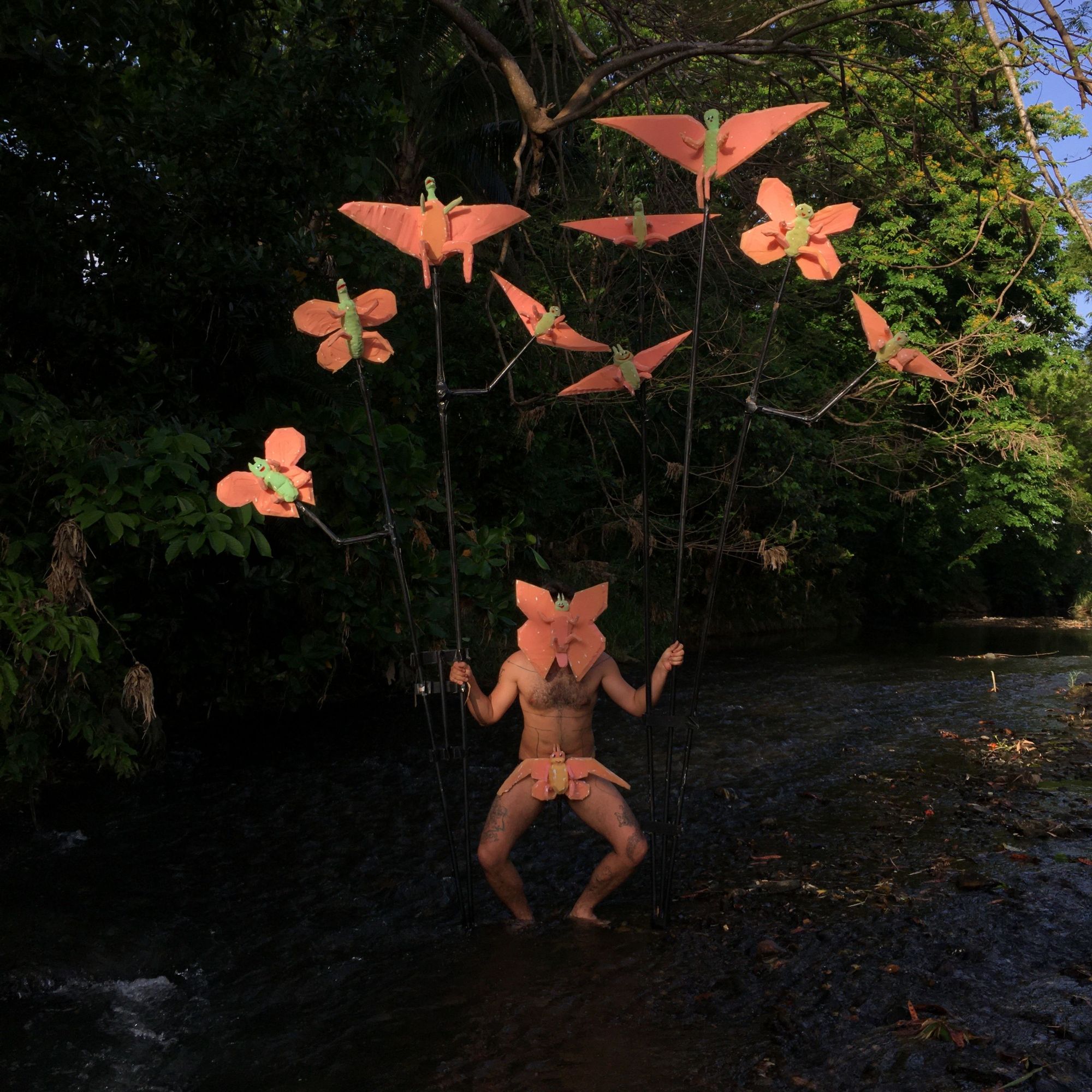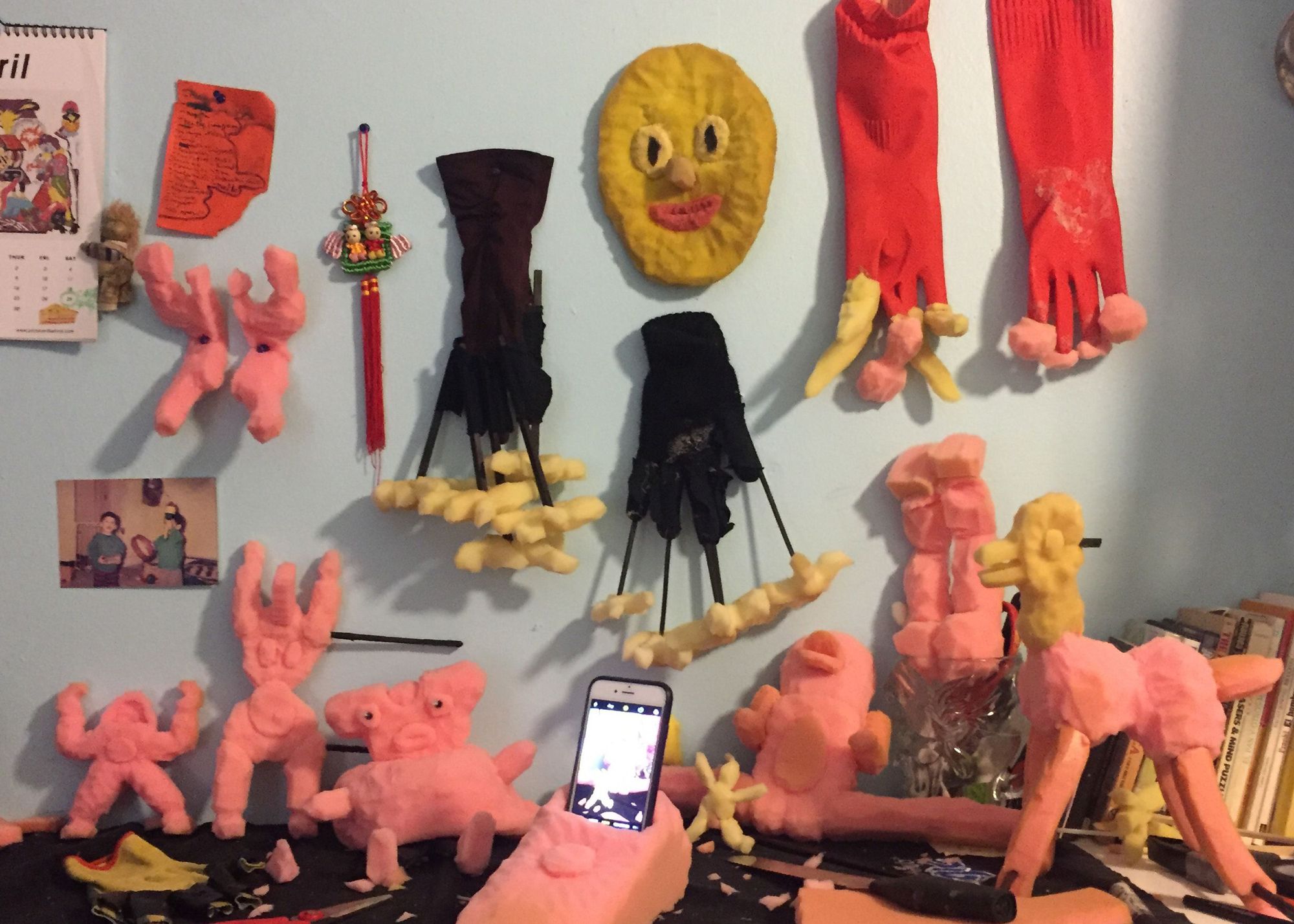Poncili Creación, Transformation and Community
“The piano ain't got no wrong notes." — Thelonious Monk
Poncili Creación is a performance collective helmed by San Juan, Puerto Rico-born and raised twins Pablo and Efraín Del Hierro. Founded somewhat organically around 2012, Poncili Creación is more than just a long running While Pablo and Efraín still perform under the name (more often than not alongside each other, but at times each one independently of the other, as if Poncili Creación were multiple performance groups), Poncili has also seen an extensive and impressive array of different lineups and collaborations. Throughout these transformations, Poncili Creación has managed to stay cohesive, recognizable, iconoclastic, even emblematic of an artistic community that has grown up on an island tormented by the forces of colonialism.
Poncili’s work has mostly consisted of performative interventions in public spaces, both announced and unannounced, where objects made out of repurposed foam rubber become manipulated either as puppets or as wearable disguises, allowing the performers to use their bodies in creative ways in order to convey a concept, narrative, or specific To most, witnessing one of their performances is always a worthwhile experience. But to be fair—and this can be taken as part of their charm—for some, the opposite might be true. This is because it takes effort to be able enjoy their shows—if by “effort” one means willingly and collectively embracing one’s inner child for a few minutes. And what type of child would one ideally have, thriving behind the ego, deep within one’s somewhat less than innocent subconscious? Probably one still ignorant of all the extensive knowledge on performance theory and the history of art they’ll gain in a not-so-far-away future. The day will come when the child will eventually pay their dues by endeavoring into the vast oceans of knowledges these subjects produce, but this child is still one that first rejoices for the box that packs the complicated toy—rather than the toy itself. The creative one, the one that would rather paint its parents living room walls with crayons instead of staying put hooked to a tv show. Or even the one that, fascinated by the viscosity and texture of white Elmer’s glue, endeavors to taste it, not caring one bit if they get ostracized by their five-year-old classmates. We want to invoke someone who can still allow themselves to enjoy the things that have nothing to do with capitalized seriousness, and a lot more to do with the village that comes together to raise its children.
A village, I might add, that for the purposes of Poncili Creación could be located in a broad range of different places. Anywhere from art fairs, galleries, museums, renowned puppetry festivals, to elementary schools, or under the streetlights of busy road-raged filled avenues, in DIY punk shows, the Puerto Rican Day parade in NYC, or the protests to oust the Governor of Puerto Rico. Almost any place seems right to let one’s inner child out, if the timing is right. Timing, in this case, is Poncili Creación coming to a place near you, without your previous knowledge. This is how I witnessed so many of their performances early on, which was closer to a “groups era” in the beginning when the different members were more actively busking than putting on the hat of the notorious contemporary artist.

This is not to say that Poncili Creación lacks knowledge in any of the relevant theory and practice of movement, puppetry, craft making, and more traditional fields of fine arts. Starting with their own parents, Mari Martín and Juan Del Hierro—who had their own art practices focused on contemporary dance in the 1980s—the twins have grown up immersed in participation within a community of renowned puppeteers, sculptors, artists, call-it-what-you-may, within the Puerto Rican artistic community. I even recently learned that Christopher Rivera, artist and co-owner of Embajada, taught Pablo’s art class in high school, where they ventured into the printing techniques that seem to be a rite of passage for any artist that’s ever been taken seriously in Puerto Rico, like Lorenzo Homar, Rafael Tufiño, Consuelo Gotay, Raquel Quijano, and Roberto "Yiyo" Tirado.
What I wish to emphasize, however, is that for Poncili Creación, one can’t just categorize or pinpoint their practice within any canonical institutionalized history. They have always been able to remain true vanguardists. What I wish to emphasize even further, however, is that the way they have been able to achieve this vanguard nature has been by nurturing and enriching themselves with the diverse talents and interests of the different communities they have worked and lived with. In this sense, the they that has held Poncili Creación together is the care entrusted by the different collaborators in both music and movement that have been part of the project one way or another. Poncili Creación has been known for enlisting the help of artists based within the parameters of the different stops along their yearly multi-continental tours, and I’m sure they are some of the most talented folks working within different artistic disciplines. Nonetheless, and wishing to keep the focus within the place the twins call home, some of the Puerto Rican collaborators that have stood out the most have been the aforementioned multidisciplinary artists Jimena Lloreda and Zuleyka Alejandro, who were always present in the beginning and whose careers have evolved into other practices, like narrative-storytelling and painting; Pablo Santiago Muñoz, who joined for some time as a musician but is known for his humorous digital media project 'Aimbot'; Paula del Toro, illustrator, tattoo-artist and fellow iconoclast friend; Alex Millán, who can rival anyone with his circus tricks; Mace Ferrer, who has scored dozens of Poncili performances and is an exceptional ceramicist, and who is a member of the performance group Lavanda; and Shanti Lalita, who is a cellist, composer, writer, and all around producer of cultural events.
The array of different focuses, outlooks, interests, skills, etc. Poncili Creación manages to tie together with their collaborators and audiences, makes witnessing them perform feel more primal than any specific thread seeking to connect institutionalized academic approaches to their art This phenomenon demands that their performances be approached and internalized in a more direct manner than the typical art aficionado’s mind, which runs wild dissecting the concepts and meaning of any given work. Since the references and/or inspiration for their performances can be traced back to an array of sources, some more explicit than others, available to most of whomever their audience is at any given time, one could say that the only necessary reference to understand their work is the reference of being alive today.

Regardless of where in the world they might be, regardless of who has joined them for a specific performance, or even whom they’re performing for, witnessing one of Poncili Creación’s shows is the equivalent of transporting oneself into a unique universe. It’s a universe which might as well be a state of mind or even an imaginary stage of sorts—one that runs exclusively on the virtuosismo of improvisation and the possibilities of movement supplied by the ways in which their foam rubber sculptures/puppets/instruments can become manipulated, similar to the way in which a jazz musician pursues new-found depths on their instrument with every new gig they play. Their sculptures’ adaptability allow for the performers to morph into them, as if they were some sort of wearable art built from a transdisciplinary approach where mask, prop, and disguise becomes the same thing. The maneuverability of their instruments pack surprise transformations, allowing also for humor to enter into the work. And while Poncili Creación has always pursued a mastery of the different instruments they craft, the duo has also evolved as conductors. In the same way a jazz musician can arrange their compositions for a number of different types of groups, from quartets to the whole orchestra, Poncili Creación works alongside their peers, but most importantly, works alongside their audience. Their commitment to transfer their actions, movements, chants, screams, etc. to those around them caught witnessing their performance remains uncompromised, notwithstanding the setting or size of their crowd.
It is fair to say that this commitment will come in handy as they get ready for their upcoming text-based online performance, premiering live on Thursday, July 30th at 9pm on the Broadcast. For this specific show, communication will be established with the audience by having them send texts to a group chat, which Poncili will then read aloud, using all the ideas shared in real-time in order to improvise a set of puppetry manipulation.
The type of audience feedback that Poncili Creación will employ in this performance is reminiscent of how they treat their audience normally, which is always a matter of collaboration. This phenomenon within the idiosyncrasy of Puerto Rico can be traced back to bomba music and its particular use of dance and movement from the audience as a way to establish a channel of communication with the musicians. In bomba, which is the name given to a genre of music played originally by both enslaved African populations and Cimarrones, the primo barrel player scores the dancing steps of whomever has stepped up to the batey (dance area) and has greeted them with a nod, communicating that they’re up for the challenge. When this happens, the primo’s higher frequency sounds and sudden blows that accompany the dancer’s steps create a unique melody directly related to all of the dancer’s movements, distinguishing its sound from the buleadores, which are the rest of the barrel drums whose job it is to keep the rhythm going alongside the singer, whose single maraca beat is the first sound one hears next to the Cuás wooden sticks. This creates a phenomenon similar to the one found within the different eras of when jazz was still played for the people and not almost exclusively within scholarly circles. That is, a stage where no performance is ever the same twice. Virtuosity, or the ability to improvise becomes synonymous with the community that finds itself talking in the music. As a Poncili performer, a jazz or bomba musician, one both adapts to the audience and is carried by their movements.
The history of dance is so important within bomba that it has come to influence the development of many other genres of music. For example, when Rafael Cortijo spotted Roberto Roena dancing, he immediately invited him to join the Combo both as a dancer and percussionist (in this case, on the Renowned sociologist Angel Quintero considers Roena to be the first dancer to ever lead an orchestra of musicians when he founded his famous “Apollo Sound” in the 1960s. Just a few years later Roberto Roena y su Apollo Sound became a mainstay of Fania Records, the leading record label within a diverse movement united into a genre of music we all know now by the apt name Johnny Pacheco and his peers gave it—Salsa. The influence of Salsa can in turn be traced to today’s Reggaeton and Latin-trap music by the likes of Tego Calderon, Ivy Queen, Daddy Yankee, Bad Bunny, Ñengo Flow, Anuel, et al.
Whether in a musical concert or in a Poncili Creación performance, when the artists and the crowd with its valiant dancers manage to leave aside their escrúpulos, they join forces for a memorable bembé. The different generations of our community, with their changing tastes in arts, music, and all the other cultural expressions of resistance, grief, and joy, become able to unite—against the violence of those which seek to oppress us—making it possible for life to flourish, even if just for a short amount of time.
BIBLIOGRAPHY
Fullana Acosta, Mariela. “Movimiento, fugas y saqueos: El archivo frustrado del performance puertorriqueño (1990-2000)”. Investigaciones en Artes Escénicas y Performáticas 1a Ed. (2012).
G., Quintero Rivera A. ¡Saoco Salsero! o El Swing Del Soneo Del Sonero Mayor: Sociología Urbana De La Memoria Del Ritmo. San Juan, P.R.: Editorial Instituto de Cultura Puertorriqueña, 2017.
Subscribe to Broadcast